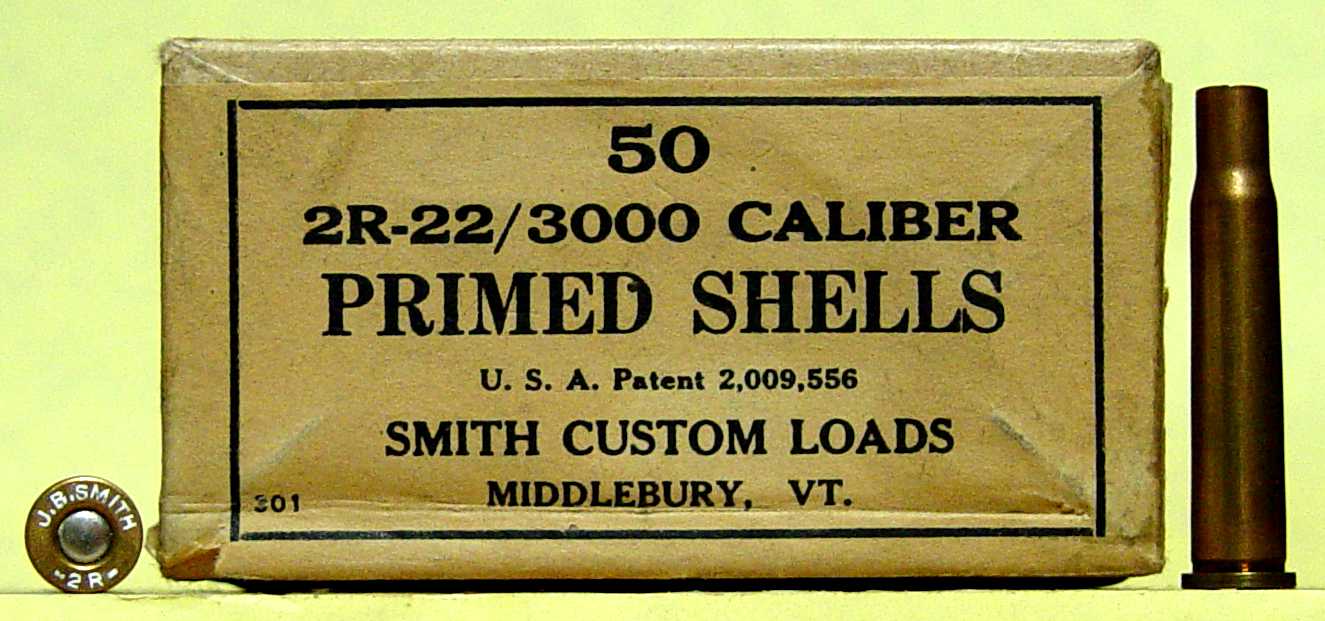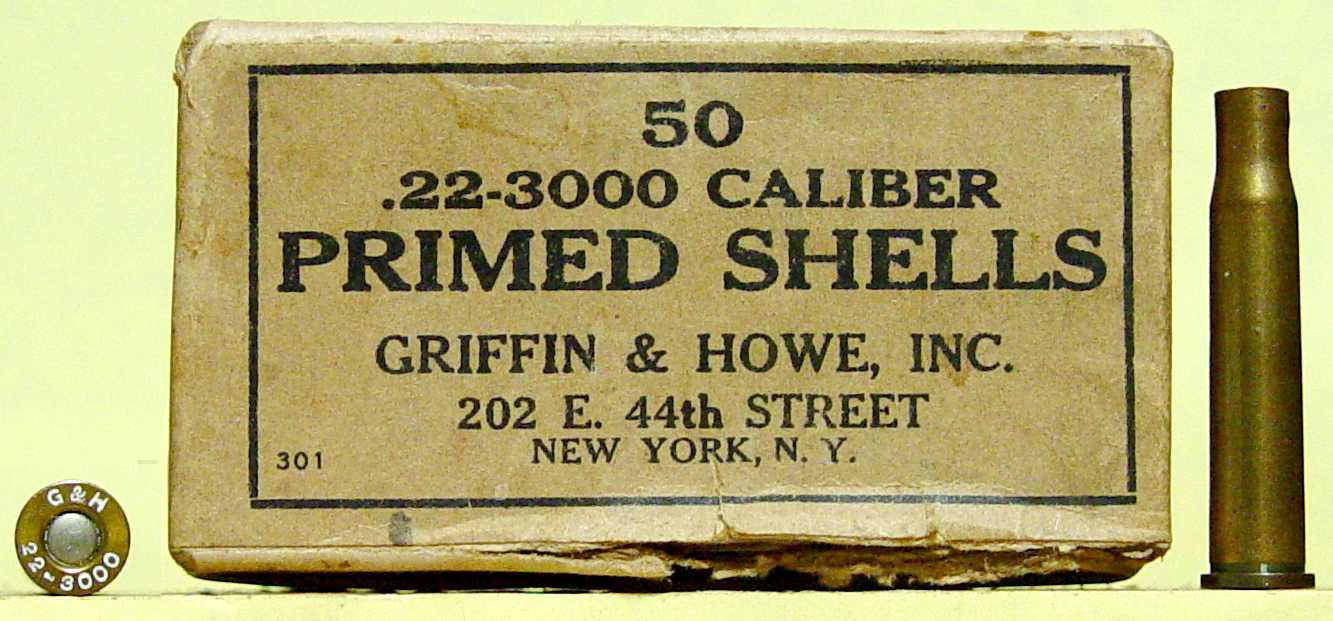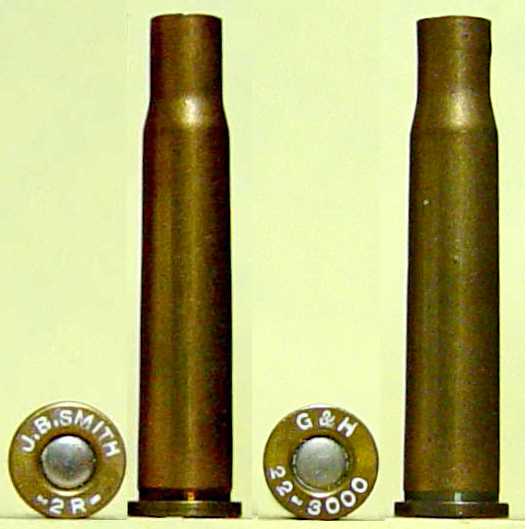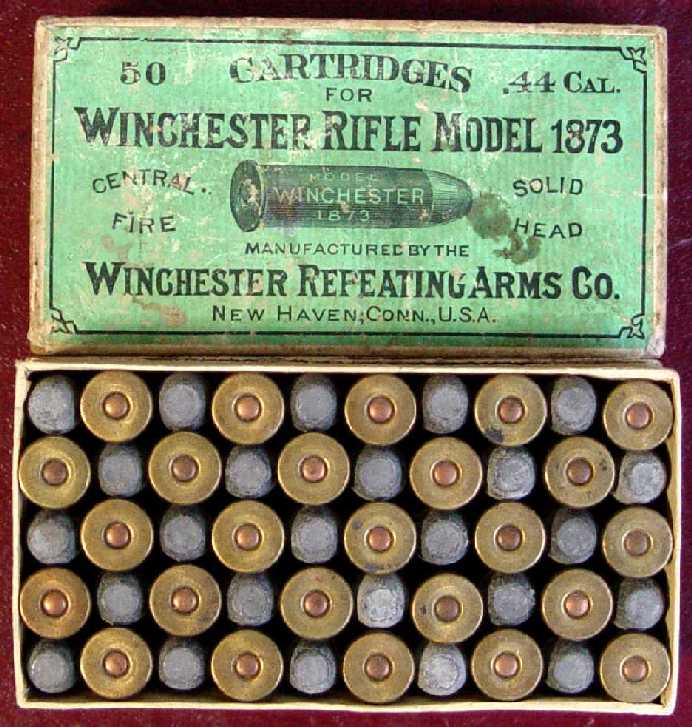|
Home of the Old Ammo Guy's Virtual
Cartridge Trading Table
Picture Page
March 2014
A box of J. Bushnell Smith 2R-22/3000
primed shells...

Here's a box of 2R Lovell, or .22-3000 'Improved' which was sold by J.B.
Smith, a Middlebury Vermont hand loader and gunsmith. J. Bushnell Smith who
custom loaded large quantities of this cartridge using cases produced for
him by Winchester Repeating Arms Co. The patent number (2,009,556) on the
box label was for an improvement in priming mixtures for small arms
ammunition issued July 30, 1935 to Joseph McNutt and assigned to Winchester;
it covers a specific non-corrosive priming mixture of the non-mercuric type.
The head stamp on the cases is J. B. Smith -2R-. The 2R in the head
stamp refers to the second reamer ground by gunsmith M. S. Risley in an
effort to produce an improved .22 Lovell (or .22-3000) case for Harvey
Donaldson, the developer of the original cartridge. This second reamer
resulted in a blown-out case with a higher, sharper shoulder. J. B. Smith
died in 1948 in a fire at his gun shop.
The patent number (2,009,556) on the box label is for the priming mixture
used in the primers, and was assigned to Winchester.
 Winchester
also made primed .22-3000 cases for Griffin & Howe, which were packed in
similar tan two-piece boxes. The head stamps in this box are G & H
22-3000. Winchester
also made primed .22-3000 cases for Griffin & Howe, which were packed in
similar tan two-piece boxes. The head stamps in this box are G & H
22-3000.
.
.
 The cartridge cases are quite similar, and I doubt that I would be able
to tell one from the other without looking at the head stamps. As can be
seen in this comparison photo, the 2R case as a slightly sharper angle
shoulder than the 22-3000, resulting in the necked portion of the case being
a little longer. The cartridge cases are quite similar, and I doubt that I would be able
to tell one from the other without looking at the head stamps. As can be
seen in this comparison photo, the 2R case as a slightly sharper angle
shoulder than the 22-3000, resulting in the necked portion of the case being
a little longer.
An in-depth discussion of the history and differences between these
cartridges occured a while ago on the International Ammunition Association's
cartridge forum; it can be found here: http://www.iaaforum.org/forum3/viewtopic.php?f=1&t=4550
The following is Julian Hatcher's account of the circumstances of Smith's
death:
The Bushnell Smith Case
J. Bushnell Smith was a well-known gunsmith and custom ammunition loader,
who had a residence with an adjoining 4 room frame shop at Weybridge,
Vermont. At 11 a.m. on July 16, 1948, I received a wire from his father
stating
that Bushnell Smith had died in a fire at his shop at about l0 that
forenoon. I
phoned the Director of Public Safety of Vermont and asked him to let me know
what had happened when his men had finished their investigation. A short
time
later he phoned me stating that his investigators were "on the ropes," and
inviting
me to come and see for myself and help his men find out the answers. The
Chief
Fire Marshal of the State met my plane at Burlington and I was at the scene
of
the fire by 6 p. m., with still some daylight left.
Smith's body was found in the lathe room of his shop, in or near the doorway
to
a room where he had five 150 lb. cans of surplus small arms powder stored,
or
7so Ibs. altogether. The shelves in another room were stacked with 20 lb., 5
lb.,
and I lb. cans of various kinds of small arms powder, and a shed against the
wall
contained large drums of kerosene or fuel oil. It is needless to point out
that the
powder in such quantities should have been in a magazine.
Smith had been adjusting a trigger mechanism which had been giving him
premature discharges, and a few moments before the accident had been firing
through an open window at a target in the woods behind the shop. The rifle,
a
.30-06, was found under his body.
From a careful evaluation of all the evidence it became apparent that Smith
had had an accidental discharge, and that the bullet had gone through the
open
door into the next room and into one of the 1 so-lb. cans of rifle powder,
which
had ignited instantly and had set off the other 4 cans. The resulting burst
of
flame through the open door had simply cooked Smith before he could move,
and had dropped him in his tracks.
Other members of his household phoned the fire department, which arrived
about l; minutes later. At that time loaded cartridges were popping off, and
they
were rather afraid to go near, but in spite of that fact they quickly got
two streams
of water on the fire, and extinguished it with much of the shop still
standing.
An examination of the rooms where the powder was stored revealed no sign of
any explosion. The powder cans were mostly split open along the seam or
bulged, but the only damage to the building was from fire.
Smith used a large number of primers in his reloading operations, and the
room
where he died had the shelves stacked with them, in the original containers,
just
as they came from the maker. Some of the shelves containing the primers had
burned through and collapsed, and the packages were charred, but apparently
none of the primers had gone off, indicating that as they are packed for
sale to
hand-loaders, they do not constitute a hazard.
Julian S Hatcher, Hatchers Notebook. 3rd ed. 1966.
.
.
.
.

|

 The cartridge cases are quite similar, and I doubt that I would be able
to tell one from the other without looking at the head stamps. As can be
seen in this comparison photo, the 2R case as a slightly sharper angle
shoulder than the 22-3000, resulting in the necked portion of the case being
a little longer.
The cartridge cases are quite similar, and I doubt that I would be able
to tell one from the other without looking at the head stamps. As can be
seen in this comparison photo, the 2R case as a slightly sharper angle
shoulder than the 22-3000, resulting in the necked portion of the case being
a little longer.